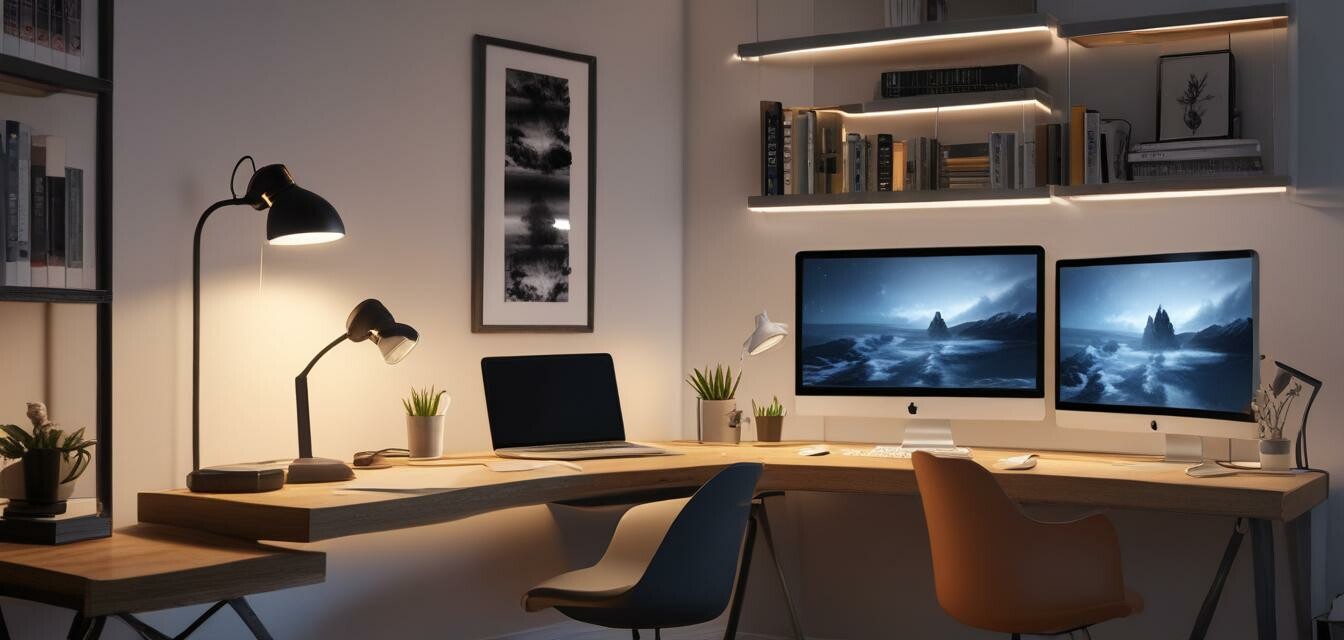
The latest trends in office lighting for productivity
Key Takeaways
- Adaptive lighting enhances productivity and comfort.
- Smart lighting systems can be customized for personal needs.
- Natural lighting has proven benefits for mood and focus.
- Energy-efficient options reduce costs and environmental impact.
- Design aesthetics are increasingly important in home office setups.
Creating an effective home office environment extends beyond just selecting the right desk and chair; proper lighting plays a pivotal role in enhancing comfort and productivity. As technology and design trends evolve, so do the various office lighting solutions available. This article explores the latest trends in office lighting that can help you create a functional, aesthetically pleasing workspace.
Importance of office lighting for productivity
Office lighting is crucial for ensuring comfort and productivity. Poor lighting can lead to eyestrain, headaches, and fatigue, while a well-lit workspace can improve focus and overall mood. To understand the impact of lighting on productivity, let’s consider some essential aspects:
| Aspect | Impact on Productivity | Recommended Solution |
|---|---|---|
| Brightness | Too dim also light can cause fatigue and distraction. | Adjustable brightness levels with smart lights. |
| Color temperature | Warm colors create a cozy atmosphere; cool colors enhance alertness. | LED lights with adjustable color temperatures. |
| Glare control | Excessive glare can lead to eyestrain and discomfort. | Use of diffusers or curtains to mitigate glare. |
Latest trends in office lighting
1. Adaptive lighting systems
Adaptive lighting systems offer the flexibility to tailor brightness and color temperature according to the time of day or tasks being performed. These systems often use sensors to adjust settings automatically, ensuring consistent comfort and enhancing productivity.
2. Smart lighting solutions
Smart lighting has transformed traditional office lighting through automation and connectivity. Through smartphone apps, users can customize their lighting experiences, scheduling when lights should turn on or off and adjusting brightness or color remotely. This feature promotes energy savings alongside personalized comfort. Interested in setting up smart lighting in your home office? Check our buying guide for expert recommendations!
3. Biophilic lighting design
This trend focuses on integrating natural elements into the workspace. Biophilic lighting mimics the natural light found outdoors, using daylight-capturing technologies like skylights or light tubes. Furthermore, it promotes a sense of connectivity with nature, positively influencing well-being and productivity.
4. Layered lighting setups
Employing a layered lighting approach combines ambient, task, and accent lighting to create a versatile and comfortable workspace. This technique can help mitigate shadows and provide various lighting options based on work type. Here’s what each layer entails:
- Ambient lighting: General illumination that fills the room.
- Task lighting: Focused lighting for specific activities.
- Accent lighting: Decorative lighting that adds aesthetics.
5. Energy-efficient lighting
With a greater focus on sustainability, energy-efficient lighting options like LED fixtures continue to gain popularity in home offices. These solutions not only lower energy consumption but also reduce heat output and contribute to a greener planet. Curious about how to enhance your home office setup? Explore our ergonomic accessories section for innovative solutions!
Ideal office lighting strategies
Implementing the latest lighting trends is essential, but understanding how to use them effectively is equally important. Here are several strategies to maximize your office lighting:
- Combine ambient and task lighting to ensure even illumination and reduce strain.
- Utilize natural light where possible by positioning your desk near windows.
- Choose adjustable or movable light fixtures to direct light where it’s needed most.
- Incorporate dimmers to modify brightness according to the task at hand.
- Regularly clean light fixtures to ensure maximum brightness and efficiency.
How to choose the right office lighting
Selecting the best lighting for your workspace requires consideration of functionality, style, and energy efficiency. An effective approach includes the following steps:
- Evaluate your needs: Identify tasks that are performed and their corresponding lighting requirements.
- Consider space layout: Analyze your office layout to determine where lighting is most necessary.
- Explore different fixtures: Research various lighting styles to find what fits your aesthetic.
- Focus on energy efficiency: Choose LED and energy-saving products to minimize costs.
Conclusion
As remote work becomes increasingly common, understanding the latest trends in office lighting is crucial for creating an environment that fosters productivity and comfort. By choosing the right lighting solutions and implementing effective strategies, you can create a workspace that not only meets practical needs but is also visually appealing.
Pros
- Enhances productivity and focus.
- Improve overall mood and well-being.
- Offers customization and flexibility.
- Promotes energy efficiency.
Cons
- Higher initial investment for smart systems.
- Requires regular maintenance for optimal performance.
Additional Resources
For further insights on creating the perfect home office setup, check out our computer peripherals section or explore innovative cool gadgets to complement your workspace.